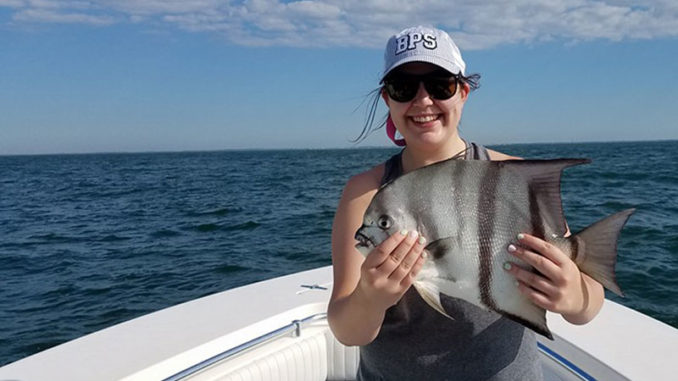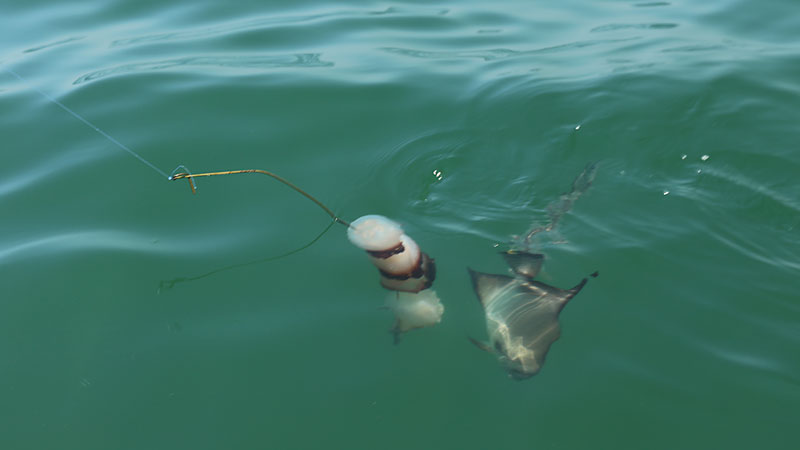
It’s spadefish time for Carolina anglers
As spring continues to warm the waters along the coast of the Carolinas, spadefish show up at many of the nearshore reefs. Some are just a few miles off the beach, offering many anglers a shot at this hard-fighting fish.
Spadefish are reef dwellers that congregate in huge numbers. One unique aspect of these fish over most reef fish is that anglers can sight-fish for them. It takes a little bit of work to get them within range, but once anglers have done their homework, they can pick and choose which fish to target with a cast.
These fish are especially attracted to reefs in the 35 to 65 foot depths. And when anglers find the reefs on their electronics, they’ll find the majority of spadefish hanging tight to the largest structures of that reef. If the reef you’re fishing has five structures and the longest one is 40 feet, target that one. If your reef has a 40-foot structure and a 200-foot structure, go after the 200.
Once anchored above that largest piece of structure, anglers can fish for spadefish passively or aggressively. Passively pursuing these fish is simple: bottom-fishing. No matter what you’re catching, if spadefish are present, their curious nature will bring them to you. They will slowly rise up to the surface as if following the fish you’re reeling in.
When they reach the surface, spadefish will swim in the shade of the boat and peck at pieces of bait thrown to them. Some anglers fill fine mesh bags with shrimp or chum and dangle them in the water. This will keep spadefish interested, giving anglers a chance to target them with small pieces of shrimp, oyster meat or the fish’s favorite meal — small pieces of jellyfish.
Do a cannonball for spadefish
For anglers who want to target spadefish more aggressively, their day starts off with netting cannonball jellyfish before heading to the reef. Some days, these are easily collected. Other days, it may take hours. On tough days, many anglers find them just off the beaches.
Once at the reef, anglers thread a stringer or a straightened wire coat hanger through about six whole jellyfish, keeping some other jellyfish onboard for later. They add a weight of about 4 ounces to the bottom of the stringer, tie the top of the stringer to a heavy line on a big rod and reel, then lower the stringer to the reef.
The angler will feel the finicky bites of spadefish once the jellyfish have reached the right depth. Then it’s time to slowly reel the stringer up, pausing to make sure the fish continue to peck at it.

When the stringer is just below the surface and surrounded by spadefish, it’s time to put that rod in a rod holder to keep the jellyfish balls in place. The spadefish will nibble at the jellyfish, swimming off to eat pieces they see break away.
Now it’s time for anglers to bait Nos. 1 to 4 hooks with small pieces cut from the jellyfish. Then, they pick out the spadefish they want to target and pitch the bait to it. It’s not uncommon for several spades to go after a piece of bait, so anglers need to be ready for a quick bite.
That bite is usually most surprising for first-time spadefish anglers.
A big surprise
Seeing a spadefish only 10 or 15 feet from the boat, they assume they’ll yank the fish in the boat on the hookset. Instead, the hookset is the beginning of one of the hardest fights they’ll ever experience, even from a small spadefish.
As long as you keep the stringer of jellyfish in the water, spadefish should continue to congregate around it. They don’t get particularly spooky when one of their fellow spadefish gets hooked, so you should be able to continue catching them for some time.
Non-typical gear
When targeting spadefish, it’s best to use gear that is slightly underpowered for most reef-fishing applications. This allows anglers to cast the small, light pieces of jellyfish accurately. Most anglers use 2500 to 3000 series spinning reels, medium or medium-light rods, and 15-pound test fluorocarbon.
No. 1 through No. 4 hooks and the bait itself usually provide enough weight to cast without adding weight to the line. This allows the bait to float naturally in front of the fish. Anglers sometimes use a bobber to keep the bait in the strike zone longer.




Be the first to comment